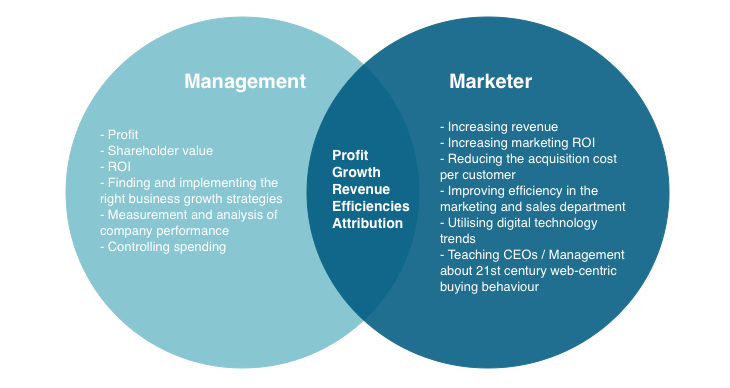How to convince the management to invest in inbound
At times, it can be difficult to get management interested in the inbound marketing hype. Fortunately, inbound is a methodology with outstanding results to show, something that will be important to you when you prove the value of the investment. Here are three ways to help you sell inbound to the management.
It's no secret that it can be a little too easy to continue with the same process you've used in recent years rather than trying out something new – it is, after all, what is most comfortable. But no companies that rely on "what we've always done" will ever experience rapid growth and shattering results.
This is just one reason why your business needs to renew their marketing strategy with a methodology that has shown excellent results for a variety of organisations across the globe – before they start lagging too far behind the competition.
Here's how to sell inbound marketing to the management:
3 ways to help you sell inbound marketing to themanagement

To get the management to understand the value of investing in the inbound methodology, there are essentially three things you need to prepare for before entering the meeting:
- Understand what concerns and contradictions management will have
- Find a common basis
- Focus on the results inbound will provide
Let's take a deep dive into the three bullet points.
1. Show that you understand the management's concerns – and disprove these concerns and contradictions
Have you ever experienced that you and your company's management live on two widely different planets? You are not alone. Because even if you feel the same pressure to deliver as well as you can, leaders will primarily have this sole concern: profitability and growth ambitions – with a limited budget.
For you to be able to explain the value of inbound to the management, you need to work to get to the same level. Management usually cares about:
- Running a profitable business
- Equity Value
- ROI
- Finding and implementing the right business growth strategies
- Measurement and analysis of company performance
- Checking money usage and getting more value out of smaller investments
It will be easier for you to present inbound and what kind of value it could give to your business if you have an understanding of what concerns management has – and thus also what contradictions they have about investing in a new marketing and sales strategy.
Once you have this in place, it's time to figure out how to best get the management to realise that inbound marketing is worth the long-term investment.
Read more: 10 common questions daily leaders have about inbound marketing - and the answers to them
2. Build a common foundation
Build a relationship and collaboration based on the fact that inbound marketing increases corporate profits and revenue through greater efficiency because the inbound methodology is measurable, attributable and predictable. In other words, build a relationship on a win-win situation for both you and the management.
Here's how to present your two different bases – and how they are aligned with the inbound methodology:

Management:
- Profit
- Shareholder value
- ROI
- Finding and implementing the right business growth strategies
- Measurement and analysis of company performance
- Controlling spending
The marketer/marketing manager:
- Increasing revenue
- Increasing marketing ROI
- Reducing the acquisition cost per customer
- Improving efficiency in the marketing and sales department
- Utilising digital technology trends
- Teaching CEOs / Management about 21st century web-centric buying behaviour
Common:
- Profit
- Growth
- Revenue
- Efficiencies
- Attribution
You must also learn to speak the same language as the management. Explain marketing concepts by using economic terms that management understands. Talk about overall strategies rather than specific marketing tactics, and be comfortable discussing overall goals and metrics you provide (e.g., ROI, LTV - Lifetime Value of a Customer and CAC - Customer Acquisition Cost).
3. Focus on the results the investment will provide – andhow they can be measured

Here you have to prove that a dedicated inbound commitment could yield higher returns than today's marketing strategy. Also, explain that the longer before you invest, the longer it will take before the results start to kick in.
Management is keen to see specific numbers and success stories. Therefore, present the potential return such methodology will provide based on statistics so that management gets an idea of what to expect from such a commitment.
Here you can, for example, highlight HubSpot's survey State of Inbound Report 2018, which includes over 6,000 respondents from Europe, North America, Australia and New Zealand, Africa, the Middle East and Latin America, where 46% of respondents said that inbound marketing gives them higher ROI.
Additionally, you can present a survey conducted at MIT (Massachusetts Institute of Technology) that took into account the returns companies have achieved by using HubSpot’s Marketing, Sales and CRM tools in their inbound strategy. It is apparent in the study that 79% of HubSpot's customers have seen an increase in sales revenue within one year after the investment.
Do you need even more good statistics to lay on the table?
- Companies that automate their lead nurturing by using a marketing automation tool like HubSpot see a 10+ % increase in total income within 6-9 months.
- Consistent implementation of inbound marketing activities is ten times more effective for lead conversion than outbound methods.
- The average cost per lead drops by 80% after only 5 months of continuous inbound marketing.
As soon as you can identify and measure marketing parameters that management can relate directly to your company's profitability and revenue, you will be able to win the management's respect.
Do you want to provide concrete figures for what ROI your company can expect from implementing inbound marketing so you can present these numbers to the management? Go ahead and download our starting kit that contains an ROI calculator and checklist for inbound success.
Real Growth. Real Impact.
HubSpot for startups: Leveraging the platform and unlocking growth w. Ragini Campion
Making AI adoption not a big deal with Mike Kaput from The AI Show
HubSpot's Spring Spotlight 2025 was not what we expected
The Power of Community in Marketing
The Return of Human Marketing in an Automated Age | Avidly Talks
How to make change projects a success - Change management tactics
How to prompt AI for great creative ideas
See why enterprises choose Avidly
Let’s build your HubSpot success story
Compelling final call to action - with accompanying link to Contact page

![[TEST]: How well does inbound marketing fit your company?](https://no-cache.hubspot.com/cta/default/308131/5dc8cd11-970b-4f27-a429-290b28a64aa5.png)







